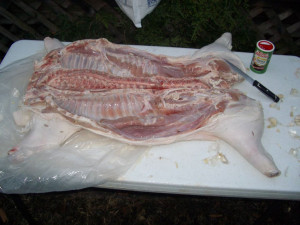It’s MMWR day again. My favorite.
A few years ago we conducted a study in commercial kitchens where we acted as food safety voyeurs and watched 47 food handlers do their job for four days.
We counted and coded all the preparation actions we could see (in some kitchens we had 8 camera angles) and there was whole lot of cross-contamination.
One cross-contamination event per food handler.
Per hour.
The MMWR note from the field detailing a 2015 Salmonella outbreak linked to a Washington State pork processor highlights the impacts of lots of cross-contamination.
A total of 192 confirmed cases were reported from five states; 184 (96%) occurred in Washington (Figure). Patients ranged in age from <1 to 90 years (median = 35 years), and 97 (51%) were female. Among 180 patients for whom information about hospitalization was available, 30 (17%) were hospitalized; no deaths were reported.
On the basis of cases investigated before August 2015, a supplemental questionnaire that went into more detail in addressing meat and livestock exposures was developed. Among 80 patients (42% of all confirmed cases) who were interviewed, 59 (74%) reported eating pork during the 7 days preceding illness. This was significantly higher than the most recently published (2007) Foodborne Diseases Active Surveillance Network (FoodNet) population survey of healthy persons, in which 43% reported eating pork in the week before they were interviewed (p <0.001) (1).
WADOH and PHSKC investigation into the source of pork traced the pork consumed by 35 (59%) of the 59 interviewed patients who reported eating pork back to a U.S. Department of Agriculture’s Food Safety and Inspection Service–inspected pork slaughter establishment in Graham, Washington. During the outbreak period, the establishment distributed whole hogs and pork parts, primarily from five farms in Montana and one in Washington, to Washington, Oregon, and Alaska. Among the 21 interviewed patients who did not report consuming pork before becoming ill, 13 had eaten at one of two restaurants or had shopped at one market where pork from the establishment was served. During June and July 2015, PHSKC inspections of these three facilities identified potential opportunities for cross-contamination of raw pork with other meat and produce, including inadequate employee handwashing and insufficient cleaning and sanitization of food contact surfaces and utensils used for raw meat. Food and environmental sampling by PHSKC at all three facilities yielded the outbreak strains.
There’s a lot of pork cooked and consumed in restaurants across the U.S. daily. And Salmonella in pork is a known issue, but there aren’t reported pork/Salmonella outbreaks every day. My guess is that incoming pork contamination levels were out of the ordinary as well.
